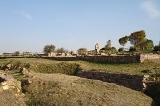
Juliobriga
Encyclopedia


Urban area
An urban area is characterized by higher population density and vast human features in comparison to areas surrounding it. Urban areas may be cities, towns or conurbations, but the term is not commonly extended to rural settlements such as villages and hamlets.Urban areas are created and further...
centre in Roman
Roman Empire
The Roman Empire was the post-Republican period of the ancient Roman civilization, characterised by an autocratic form of government and large territorial holdings in Europe and around the Mediterranean....
Cantabria
Cantabria
Cantabria is a Spanish historical region and autonomous community with Santander as its capital city. It is bordered on the east by the Basque Autonomous Community , on the south by Castile and León , on the west by the Principality of Asturias, and on the north by the Cantabrian Sea.Cantabria...
, as stated by numerous Latin authors including Pliny the Elder
Pliny the Elder
Gaius Plinius Secundus , better known as Pliny the Elder, was a Roman author, naturalist, and natural philosopher, as well as naval and army commander of the early Roman Empire, and personal friend of the emperor Vespasian...
. The site has traditionally been identified with ruins in the village of Retortillo (Cantabria) and its Villafría district, in the municipality of Campoo de Enmedio
Campoo de Enmedio
Campoo de Enmedio is a municipality located in the autonomous community of Cantabria, Spain. According to the 2007 census, the city has a population of 3.996 inhabitants. Its capital is Matamorosa.-External links:* - Cantabria 102 Municipios...
.
Its founding, during the Cantabrian Wars
Cantabrian Wars
The Cantabrian Wars occurred during the Roman conquest of the modern provinces of Cantabria, Asturias and León, against the Asturs and the Cantabri. They were the final stage of the conquest of Hispania.-Antecedents:...
(29 BC-19 BC), made it a powerful symbol of Roman domination of the tribes of the Cantabri
Cantabri
The Cantabri were a pre-Roman Celtic people which lived in the northern Atlantic coastal region of ancient Hispania, from the 4th to late 1st centuries BC.-Origins:...
. The city was named after the reigning emperor Augustus
Augustus
Augustus ;23 September 63 BC – 19 August AD 14) is considered the first emperor of the Roman Empire, which he ruled alone from 27 BC until his death in 14 AD.The dates of his rule are contemporary dates; Augustus lived under two calendars, the Roman Republican until 45 BC, and the Julian...
and his adopted family name, the gens
Gens
In ancient Rome, a gens , plural gentes, referred to a family, consisting of all those individuals who shared the same nomen and claimed descent from a common ancestor. A branch of a gens was called a stirps . The gens was an important social structure at Rome and throughout Italy during the...
Julia
Julius
The gens Julia was one of the most ancient patrician families at Ancient Rome. Members of the gens attained the highest dignities of the state in the earliest times of the Republic. The first of the family to obtain the consulship was Gaius Julius Iulus in 489 BC...
, with the Celtic
Celtic languages
The Celtic languages are descended from Proto-Celtic, or "Common Celtic"; a branch of the greater Indo-European language family...
toponym element -briga, common in Iberia. Due to its strategic location in the Besaya valley
Besaya Valley
The Besaya valley is both a comarca located in the center of Cantabria, along the course of the Besaya River, and the natural valley of said river. Its capital is Torrelavega.- The Besaya River Basin :...
, it was able to control trade between the Douro
Douro
The Douro or Duero is one of the major rivers of the Iberian Peninsula, flowing from its source near Duruelo de la Sierra in Soria Province across northern-central Spain and Portugal to its outlet at Porto...
river and the Bay of Biscay
Bay of Biscay
The Bay of Biscay is a gulf of the northeast Atlantic Ocean located south of the Celtic Sea. It lies along the western coast of France from Brest south to the Spanish border, and the northern coast of Spain west to Cape Ortegal, and is named in English after the province of Biscay, in the Spanish...
. Juliobriga grew slowly, reaching its peak between the end of the 1st century and the early 2nd century AD. Following that, its population began to decline, until the city was completely abandoned in the 3rd century.
The ruins of Retortillo were first identified with Julióbriga in the second half of the 18th century by Enrique Florez
Enrique Florez
Enrique Flórez de Setién y Huidobro was a Spanish historian.Florez was born in Valladolid. At 15 years old, he entered the order of St Augustine. He subsequently became professor of theology at the University of Alcala, where he published a Cursus theologiae in five volumes...
. Numerous historians and archaeologists have worked on the site since, including some of Spain's foremost. The ruins of Juliobriga were declared a Heritage Site by the Spanish Government on March 29, 1985.

